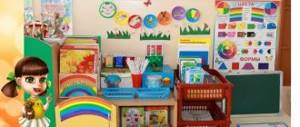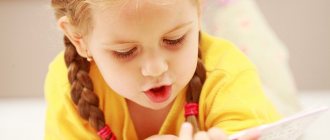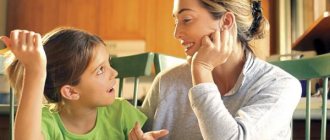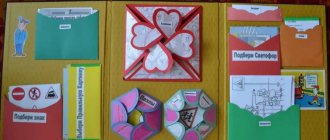TRIZ for speech development: how to write riddles?
Why do they make and guess riddles?
Because children love to reveal secrets. It is a fact. They also love to remember what they hear and then test each other.
How do you usually get acquainted with riddles? An adult reads a new riddle to the children. As a rule, the smartest child (probably through insight) guesses what the answer is (or in more complex cases, the person who made the guess himself suggests until it dawns on someone). The rest of the children listen and remember. When the same riddle is repeated after some time to the same children, we see a “forest of hands.”
But if you dig deeper, then such “knowledge” of riddles and, accordingly, the ability to remember the desired answer is simply a memorization skill. Thinking doesn't work, and creative thinking doesn't work either. Yes Yes.
So, it is much more useful to learn to write riddles yourself.
This is not at all difficult to do, even for the little ones (with a little help from an adult).
Why? Because wonderful authors (hereinafter, three-page odes to them)) have already come up with simple and effective algorithms for this.
Simple models for writing riddles for little ones
(from T.A. Sidorchuk and A.A. Nesterenko)
Children 3-4 years old can come up with riddles based on these models.
Model 1
1. Figure out what the riddle will be about,
2. Select the main properties of this object (no more than 4),
3. For each property, select another object that has the same property.
In other words, write down the characteristics schematically, based on the table. Let our riddle be about a kitten.
Add linking words and get a riddle:
Affectionate, but not the sun,
Warm, but not a sweater,
Mustached, but not a catfish.
Model 2
Similarly, you can create simple riddles based on the actions that the object performs. It is better to take as a basis an object that can have 2-3 properties associated with movement, sound, light effects, and smells.
I'm talking about the kitten again.
The result is a riddle:
Hunts, but not a wolf,
Can jump, but not a ball,
It rumbles, but not the engine.
Model 3
Here we need to write down in the table what object our answer is similar to and how it differs from it. Once again about the kitten:
Looks like a toy, but alive,
Looks like a lion, but without a mane,
Looks like an owl, but does not fly.
There is absolutely no need to draw signs every time! It is enough to mentally imagine the desired model. And you can even combine two models in one riddle.
If you look at this way of coming up with riddles more broadly, you can use it with older students to better memorize scientific concepts from chemistry, physics, and biology. What helps with this is that in the process of composing, imaginative thinking is involved, and, therefore, memorization is more effective.
A way to write a riddle for children over 7 years old
(from A.V. Kislov and E.L. Pchelkina)
The steps of the algorithm are partly similar to those already described, but there are a little more of them:
1. Select an object; 2. Select from 1 to 3 properties of the object - visible, audible, tangible, tasteful, constant or changeable; 3. Each highlighted property is supplemented with an image that arises by association; 4. Imagine yourself in the place of the original object and describe the associated impression; 5. Select the most vivid, interesting and original descriptions from points 3 and 4, combine them into a short story or poem.
The guys and I came up with a riddle about a faulty light bulb that was blinking above our heads. Of course, I did not write down the algorithm itself word for word, but simply indicated the steps with icons. Here's how it happened.
It doesn’t matter if the riddle doesn’t add up to a poem! Prose riddles and stories are also very interesting and unusual, and most importantly, they encourage verbal creativity.
Share your original riddles in the comments!
LiveJournal
speech development
You may also be interested in: 12 Creative Things to Do for Spring
Development of imaginative thinking: blotography, handprint and other interesting things
TRIZ game “Wonderful Things”
19 activities for creative development
Methods of teaching children to write riddles
On the influence of riddles on the development of speech in preschool children
Guessing and inventing riddles has an impact on the diversified development of children's speech. To create a metaphorical image in a riddle, use various means of expressiveness (device of personification, use of polysemy of words, definitions, epithets, comparisons, special rhythmic organization)
contribute to the formation of figurative speech in preschool children.
Riddles enrich the vocabulary due to the polysemy of words, help to see the secondary meanings of words, and form ideas about the figurative meaning of a word. They help to master the sound and grammatical structure of Russian speech, forcing you to focus on the linguistic form and analyze it.
Riddles develop a child's ingenuity and intelligence. A riddle is presented - the questioner puzzles over the answer. The bolder the invention, the more difficult the riddle to solve. Improbability gives the images of the riddle a clearly realized contradiction of reality, and the answer brings order to the confusion: everything falls into place, in accordance with the actual qualities of the riddled object.
In other words, a riddle indicates special signs and properties that are unique to the object being riddled.
It is based on the similarity and denial of similarity between objects. This property of a riddle introduces the child to thinking about the connections between phenomena and objects of the surrounding world, as well as about the characteristics of each object and phenomenon.
Solving riddles develops the ability to analyze, generalize, and forms the ability to independently draw conclusions and conclusions. The ability to clearly identify the most characteristic, expressive features of an object or phenomenon, the ability to vividly and concisely convey images of objects, develops in children a “poetic view of reality.”
The objectivity, specificity of the riddle, and focus on detail make it an excellent method of didactic influence on children. In your work, you can offer children riddles at the beginning of classes, observations, and conversations. In these types of work, the riddle arouses interest and gives rise to a more detailed conversation about the object or phenomenon of interest. These forms of folklore bring a certain “spice” to classes; they force you to take a fresh look at certain objects, to see something unusual and interesting in things that have long been familiar.
Methodists suggest using riddles not only at the beginning and during the activity, but also at its completion. For example, by examining objects, comparing and contrasting them, finding similarities and differences between them, children come to conclusions and express them in words. A riddle can serve as a kind of completion and generalization of the process of activity, helping to consolidate the signs of an object in the minds of children. This technique helps to concretize children's ideas about the characteristic properties of an object or phenomenon. Thus, riddles help children understand how, succinctly and colorfully, using linguistic means in different ways, one can say the same thing.
In the practice of teachers working with children with various speech disorders, riddles, a compact and interesting folklore form, are widely used. The main feature of the riddle is that it is a verbal-logical task.
To guess a riddle means to answer a question, that is, to perform a complex mental operation. The object in question in the riddle is hidden, encrypted, and the methods for deciphering it are different.
The correctional and developmental possibilities of the riddle are varied. The most important of them are:
- nurturing resourcefulness, quick wits, and speed of reaction;
- stimulation of mental activity;
- development of thinking, speech, memory, attention, imagination;
- expanding the stock of knowledge and ideas about the world around us;
- development of the sensory sphere.
This is especially true for children with general speech underdevelopment (GSD)
, because in this case the riddle becomes significant practical material for the correction and formation of the child’s correct speech.
Methods of teaching children to write riddles
Traditionally, in preschool childhood, working with riddles is based on guessing them. Moreover, the methodology does not give specific recommendations on how and how to teach children to guess hidden objects.
Observations of children show that guessing occurs in the most intelligent preschoolers, as if by itself or by enumerating options. At the same time, most of the children in the group are passive observers. The teacher acts as an expert. The correct answer of a gifted child to a specific riddle is very quickly remembered by other children. If the teacher asks the same riddle after some time, then most of the children in the group simply remember the answer. When developing a child’s mental abilities, it is more important to teach him to compose his own riddles than to simply guess familiar ones.
A. A. Nesterenko developed models for composing riddles for school-age children. In an adapted version, this technology allows preschoolers to be taught how to write riddles. In the process of composing riddles, all the child’s mental operations develop, and he receives joy from verbal creativity.
Teaching children to write riddles begins at the age of 3.5 years. In the practice of working with preschool children, three main models of composing riddles are used. Training should proceed as follows.
The teacher hangs up one of the signs with a picture of a model for composing a riddle and invites the children to make up a riddle about an object.
Model 1
(application 1)
| Which? | What happens the same? |
(samovar) has been chosen to compose a riddle.
. Next, the children give figurative characteristics according to the characteristics specified by the teacher.
— What color is the samovar? - Brilliant.
The teacher writes this word in the first line on the left side of the table.
- What kind of samovar does it do? — Hissing (fill in the second line on the left side of the table)
.
- What is its shape? - round (fill in the third line on the left side of the table)
.
The teacher asks the children to make comparisons based on the listed values of the signs and fill in the right lines of the table:
| Which? | What happens the same? |
| Brilliant | coin |
| Hissing | volcano |
| Round | watermelon |
Next, children are asked to give figurative characteristics to the objects selected for comparison (right side of the table)
.
PR: shiny - a coin, but not a simple one, but a polished coin.
The plate might look like this:
| Which? | What happens the same? |
| Brilliant | Polished coin |
| Hissing | Awakened volcano |
| Round | Ripe watermelon |
After filling out the tablet, the teacher offers to read the riddle, inserting the connectives “How” or “But not” between the lines of the right and left columns.
Reading the riddle can occur collectively by the entire group of children or by any one child. The folded text is repeated repeatedly by all children.
The final riddle about the samovar: “Brilliant, like a polished coin; hissing like an awakened volcano; round, but not ripe watermelon.”
Recommendations:
It is advisable to denote the meaning of a feature on the left side of the table with a word with a clearly marked first letter, and on the right side a sketch of the object is acceptable. This allows you to train children's memory: a child, who cannot read, remembers the first letters and reproduces the word as a whole.
After mastering the “Which - What is the same” model
At an active level, it is necessary to introduce children to the features of comparisons.
Riddles can be made on the basis of “underestimating” the properties of objects (the samovar is dull, like unclean shoes)
or “overstating” them
(the samovar is shiny, like a polished coin)
.
Model 2
(Appendix 2)
The methodology for working with model 2 is similar to working with the first model.
A table is hung in front of the children, which is gradually filled in (first on the left and then on the right side)
.
| What is he doing? | What (who) does the same? |
Protocol for composing a riddle about a hedgehog with children 5 years old.
- What is the hedgehog doing?
- Puffs, collects, minces.
- Is he puffing like someone or what?
— Puffs like a brand new locomotive (comparison is “overstated”)
.
— Puffs like an old kettle (comparison to “understatement”)
.
— Collects like a good housewife (comparison to “overstatement”)
.
— Collects like a greedy person (comparison to “understatement”)
.
- Minces around like a child learning to walk (overstated comparison)
.
— Mincing like an old grandfather (comparison to “understatement”)
.
Next, the teacher suggests composing the riddle as a whole, using the connectives “How”, “But not”.
PR: Making up a riddle about a hedgehog using the “overstatement” technique: “Puffs like a brand new train; collects like a good housewife; minces, but not a child who learns to walk.”
| What is he doing? | What (who) does the same? |
| Puffs | Brand new engine |
| Collects | Good hostess |
| Mince | A child learning to walk |
PR: Making up a riddle about a hedgehog using the “understatement” technique: “It’s puffing, but not a broken kettle; collects, but is not greedy; minces like an old gnome.”
| What is he doing? | What (who) does the same? |
| Puffs | Broken kettle |
| Collects | Greedy |
| Mince | Old gnome |
Model 3
(Appendix 3)
The peculiarity of mastering this model is that the child, comparing one object with some other object, finds common and different features between them.
| What does it look like? | What is the difference? |
Protocol for composing a riddle about a mushroom:
-What does a mushroom look like? - For a peasant.
- How is it different from a peasant? — The mushroom has no beard.
-What else does it look like? - To a house, but without windows.
- What else does it look like? — Like an umbrella, but the umbrella has a thin handle.
Next, the teacher suggests composing the riddle as a whole, using the connectives “How” or “On”, “But on” or “But without”.
| What does it look like? | What is the difference? |
| Little guy | No beard |
| House | No windows |
| Umbrella | Thin pen |
The text of the resulting riddle: “Looks like a peasant, but without a beard; looks like a house, but without windows; like an umbrella, but with a thick stem.”
The role of riddles is great. They have a great influence on the development of children’s speech, on the enrichment of vocabulary, on the development of children’s imagination and thinking, on the enrichment of their ideas about the world around them, on the education of aesthetic feelings, on the development of the child as a whole.
Recommended pages:
Use the site search:







